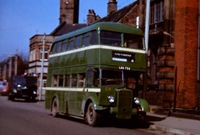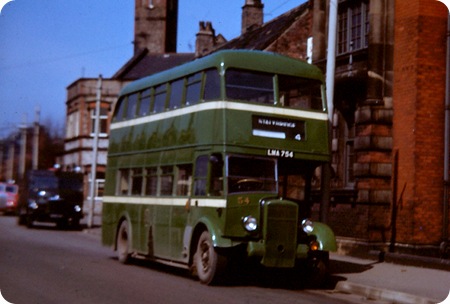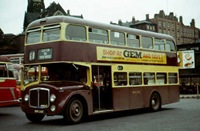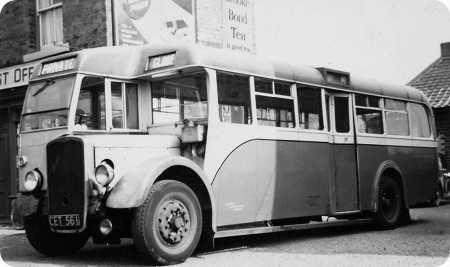S H M D – Daimler CVD6 – LMA 754 – 54
Stalybridge, Hyde, Mossley and Dukinfield
1949
Daimler CVD6
East Lancs H30/26R
The name of this operator is shortened to S.H.M.D. thankfully, its full name was as follows “Stalybridge, Hyde, Mossley and Dukinfield Joint Transport Tramways/Transport and Electricity Board” (see comments below).
Stalybridge, Hyde, Mossley and Dukinfield are 4 towns to the east of Manchester. This Daimler had an East Lancs body which was a rare thing as to say they preferred Northern Counties would be an understatement.
S.H.M.D. got together with Atkinson and Northern Counties and in 1955 the only Atkinson double-decker ever built went into service but nothing ever became of the venture and in 1969 it passed over to SELNEC.
A full list of Daimler codes can be seen here.
———
The Atkinson ‘decker No. 70 (UMA 370) was restored at Stalybridge on withdrawal and presented to the Greater Manchester Museum of Transport, where it still lives. It does come out from time to time and still goes well.
SHMD had ten of those East Lancs bodies, and ten Brush bodies just after the war; it was just a case of "grab what you can" in the post-war shortage of new buses. The East Lancs bodies must have been good as they lived a full life; the Brush were rubbish and were replaced by NCME ones after six years.
David A Jones
———
Number 70 was not the only Atkinson double-decker built there were two one which was sent to India.
Peter Barber
———
SHMD were on of the last operators to use centre entrance deckers buying them as late as the nineteen fifties. As well as the solitary Atkinson one other SHMD bus with centre entrance is still in existence being a Daimler CVG6 with Northern Counties body that lives at the Keighley bus museum. They also have a SHMD Atkinson Alpha centre entrance saloon under restoration.
Chris Hough
———
I was one of the last two apprentices to be taken on by SHMD in 1968, and have worked on the No70 bus along with a host of others. If you need any further information re SHMD please contact me through this site.
Andrew Paul Roberts
———
Please note that you have fallen for the common mistake of including the word "Joint" in describing the full name for the SHMD. It was always the "Stalybridge Hyde Mossley and Dukinfield Tramways and Electricity Board". The trams themselves did show various nomenclatures such as "Joint Board" and that was the term commonly used among local passengers at the time. But the word "joint" was never part of the official name. I am sorry that you did not think to check this out before posting this on-line.
David
———
I agree that the word Joint didn’t appear in the official title, but it was not "always" Tramways. The name was changed to Stalybridge, Hyde, Mossley and Dukinfield Transport and Electricity Board in 1936.
Peter Williamson
———
The buses originally carried an "SHMD Joint Tramways" fleet name which then became "SHMD Joint Board" but this was later shortened to "SHMD Board" until the longer title was adopted in much smaller lettering in the early sixties.
Once the device was adopted, for some reason as a general rule double-deckers had the multiple coats-of-arms device between SHMD and Board whereas single deckers only had the lettering.
David Beilby
———
All Employees and Management through out my time at SHMD, along with the local people knew the company as Joint Board. Yes the Buses had both the monograms and the lettering, but it was always known as Joint Board. I may have letters from SHMD, so I will check to see how they have signed them
Andrew Paul Roberts
———
OK, so I was lazy in saying the title was "Always Tramways etc.; I know it changed to "Transport". And of course it always included "and Electricity" even after that responsibility was lost, but that bit was dropped from the full title as shown on the vehicles in later years.
The point I was making was that, though everyone in the area always called it "the Joint Board", and that was an accurate description of its legal status and function, and the term was used on the vehicles, it was never the legal name of the organisation. That was enshrined in the Stalybridge, Hyde, Mossley & Dukinfield Tramways and Electricity Board Act of 1900. Because everyone knows it had the longest name in the business, everybody seems to want to embellish it unnecessarily with another word to make it sound more eccentric!
This is of course an old Stalybridge tradition, since the town famously boasts what is alleged to be the longest pub name in the world as well:
"The Old Thirteenth Cheshire Riflemen Voluntary Corps Inn"
I’ve seen this with extraneous words added by helpful admirers too!
David Jones
———
19/03/11 – 07:33
A bit of trivia, in John Schlesingers film ‘Yanks’ the decker used in an early scene the conductress’s hat badge reads ‘Stalybridge and District’ why they didn’t use SHMD I don’t know as the continuity in the film was quite good otherwise.
Roger Broughton
———
29/11/11 – 18:01
I haven’t watched the excellent film "Yanks" for a good while now, but much of it was filmed in Keighley and I think the bus concerned was Keith Jenkinson’s Keighley-West Yorkshire Titan JUB 29 wasn’t it ??
Chris Youhill
———
30/11/11 – 06:25
Yes it was Keith Jenkinson’s JUB 29 Chris. I remember it spending a short time in West Yorkshire’s Body Shop for a general sprucing up after filming had finished. It was tucked snugly in the back left-hand corner (viewed from Westmoreland Street) and achieved almost ‘local celebrity’ status with some of the older staff during its brief stay. Like you, I’ve never seen the film, but know that quite a lot of the scenes were shot around Keighley and its railway station. That would tie in very nicely with the Keighley-West Yorkshire vehicle, not to mention the splendid engines of the Keighley & Worth Valley Railway.
Brendan Smith
———
22/07/12 – 08:02
I remember the Crossley Omnibus Society – or maybe its BWBE predecessor – running a tour with no 70. I don’t remember where we went (probably somewhere in Yorkshire) but I do recall it was a very nice bus to ride.
My other strong memory of the SHMD is a ride on the Haughton Green – Hyde service on an ancient Daimler which had a rope bell. I had heard about these being used on some old trams, but it’s the only time I remember seeing one on a ‘modern’ bus.
Brian Wainwright
———
23/07/12 – 08:02
SYPTE specified rope bell-pulls on its Leyland Atlanteans and Dennis Dominators – in First Bus days one of the Dominators was allocated to First Calderdale.
Philip Rushworth
———
 Vehicle reminder shot for this posting
Vehicle reminder shot for this posting
———
01/12/12 – 16:13
I have just had a great time looking at the pictures and reminiscing about "the good old days" I was a fitter at the depot on Tame Street along with Andy Roberts. I will try and dig out some old photos and post them.
Derek Gibson
———
02/12/12 – 13:58
BELLS ON THE SHMD
Some early trams were fitted with electric bells according to Hyde & Ogden in their SHMD Board book. These gave trouble and were replaced. Manual bells were fitted to buses using a continuous jointed leather thong. The Daimler demonstrator double decker 168 delivered in 1936 had but two bell pushes in the lower saloon, which the conductors found insufficient. When incorporated into the fleet it was fitted with the continuous thong bell which on double deckers ended over a pulley and hung down on the platform of double deckers. In the older vehicles the thong was looped through the grab rail along the ceiling, later buses had holders provided. I think more modern buses were fitted with m continuous bells connected to an electric bell in the cab. Upstairs the original Daimler double deckers had a single pneumatic bell at the top of the stairs, with a more modern bellpush than that on the Manchester trams. I recollect that Liverpool’s older trams had a flat strap bell along the middle of the ceiling of the lower deck.
Mr Anon
———
02/12/12 – 16:31
The Daimler demonstrator of 1936 is referred to in Hyde & Ogdens fleet list as : fleet No 168 Reg No BWK 860. Daimler Chassis COG6 with Weymann Body. Withdrawn 1950. Is this the same as the Daimler CVD6 referred to in your appended comment ?
Mr Anon
Quick links to the - Comments Page - Contact Page - Home Page





